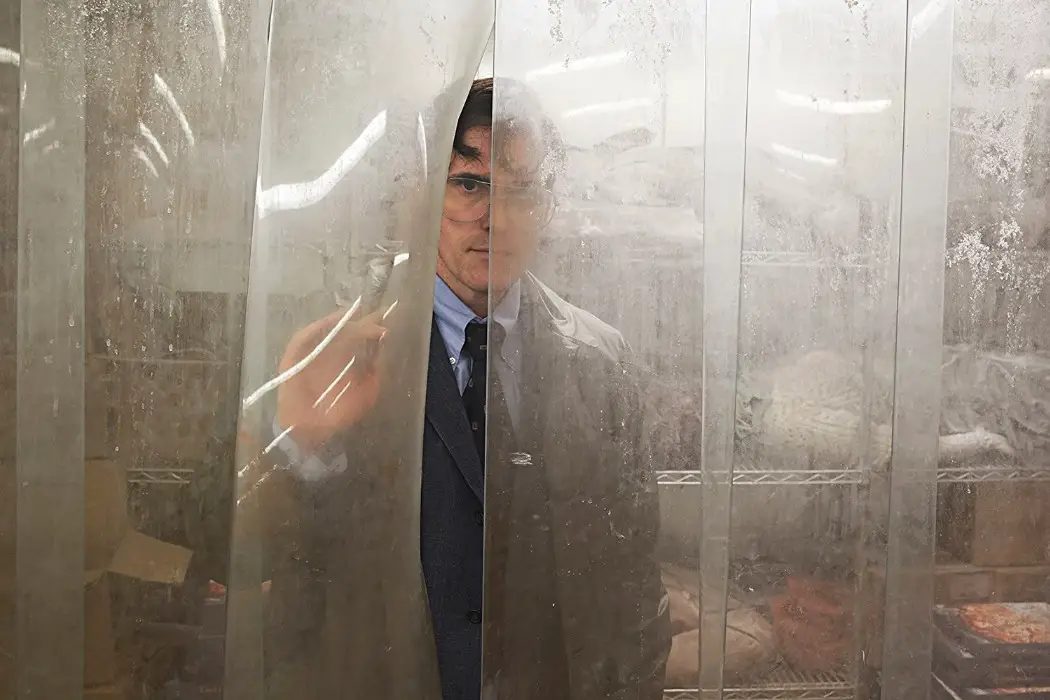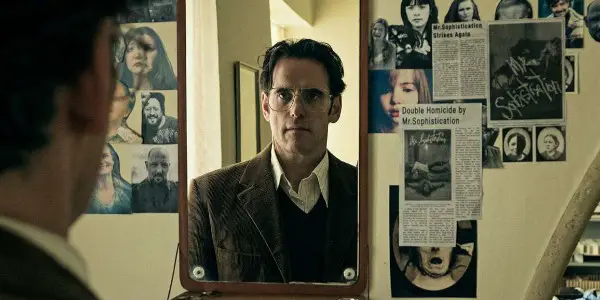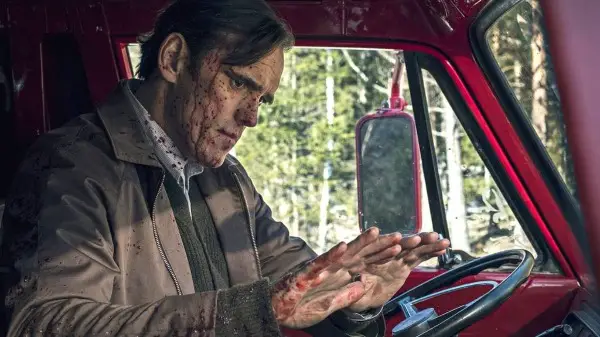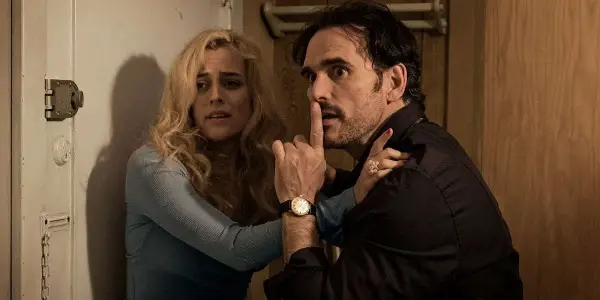THE HOUSE THAT JACK BUILT: A Journey Into The Darkest Depths Of Lars Von Trier’s Mind

Alistair is a 25 year old writer based in Cambridge.…
Lars Von Trier may have the infamous reputation of being the most notorious edgelord of arthouse cinema, but it feels like his history of provocative comments is starting to catch up with him. Think back to 2011, when he began his Melancholia press tour telling reporters that he thought his own film was “boring”, before getting himself declared persona non grata at the Cannes Film Festival for claiming to understand Hitler.
In the immediate aftermath, he naturally defended the comment by reminding everybody that it was a misjudged joke and Danish humour doesn’t translate well, before going on to make a four hour porn epic that seemed like a self-reflective allegory for his own career in a moment of crisis.
Lars and the Real Murderer
Although it’s been seven years since his cringeworthy attempts at humour, the spectre of that press conference hangs over every frame of The House That Jack Built. His latest film uses a similarly self-analytical conceit to Nymphomaniac, as a series of random incidents in the titular character’s life are dissected in extensive detail through the guise of being questioned by a quasi-audience surrogate bemused by their actions. Jack’s cold-blooded murders are presented as allegories for Von Trier’s own creative process, but the film cuts far deeper than merely reshaping the same allegory as his previous film.
Whereas Von Trier previously joked he “understood” a man responsible for the biggest atrocities ever committed, here he equates himself with a serial killer to try and see if they both see the process of creating art through a warped lens – and whether or not he is capable of sincerely understanding a man responsible for committing great evil. One of the most surprising things about The House That Jack Built is that even Von Trier, a filmmaker with a penchant for nihilism, struggles to find any humanity within a monster built to resemble himself.

Set across a number of years throughout the back half of the 20th Century, The House That Jack Built follows the titular character (Matt Dillon), discussing key moments in his criminal life to Verge (Bruno Ganz), an unseen narrator who appears to him prior to committing his most brutal act yet. Although an architect by profession, Jack’s life slowly got consumed by his serial killing hobby; starting with the unplanned murder of an irritating woman (Uma Thurman), we see various “kills” in his decade long spree that illustrate how his lack of humanity has helped him create what he sees as powerful art works.
Originally conceived as an extensive TV series, one of the few flaws of The House That Jack Built is the fact that it eventually stretches out its central metaphor to the detriment of the film around it. Von Trier’s necessity for self analysis in-between the different episodic murders becomes increasingly repetitive, at times simply rehashing the same moments of self criticism from his previous film. At one point, an extensive monologue about the pain and suffering that goes into art blossoms into a montage of random scenes from his filmography, as if anybody was still struggling to grasp the entire thing is a twisted euphemism for his tortured creative process.
If this doesn’t becoming grating enough, the voiceover discussions on the subject between Dillon and Ganz are hindered by a distracting echo effect on their vocals, intended to mimic the sounds of two men speaking from an otherworldly realm, yet in practice sounding like Von Trier forgot to choose the correct vocal setting on Garageband. The self reflection isn’t a problem; instead, the issues stem from the fact the narrated arguments don’t progress after making their initial point, especially when the same theme being analysed so intensely in these moments is central to the narrative itself, making the digressions increasingly unnecessary.
A Film only Von Trier could have made

The character’s earlier attempts at serial murder are defined by their sheer ineptitude; in the film’s standout comic moment, Jack desperately tries to get into an elderly woman’s house under the guise of being a policeman, only to then change track and declare himself an insurance salesman halfway through. Dillon mines comic gold from the sheer desperation in this circumstance, and yet in retrospect this might be the most shocking thing Von Trier has achieved with the film. Making you expect more subsequent dark comedy, before pulling the rug from under our feet and throwing us into a literal and metaphorical journey into the depths of hell, where no sliver of comedy can undermine the invasive nihilism.
There are still moments of deadpan absurdism firmly in the background (from the fact Jack’s freezer has little space for corpses due to excess amounts of frozen pizza, to the crime scene item he uses as a wallet), but after slowly gaining a sickening amount of broad comic gravitas, we eventually start to see the making of a true psychopath. We are told Jack has murdered over sixty people, with the story unfolding over an indefinite amount of time – and as we get deeper into his “career”, so to speak, Dillon‘s performance becomes one of the most unsettling in the director’s filmography. Which is truly saying something.
The more depraved Jack gets, the more apparent it is that Von Trier is using the character as a means of analysis to the controversies that have followed him throughout his career. The vast majority of his victims we see are women, and prior to murdering one of them (a woman he nicknames “simple”, played by Riley Keough), he goes on an extensive diatribe about how he detests a society that he believes positions men as being responsible for all the evil in the world.

Although there’s an unintended dark comedy to hearing a serial murderer of women espouse views straight from the men’s rights activist playbook, especially in an era when society is finally reckoning with these extreme views, this is more clearly drawn to display the most extreme parallels with Von Trier himself. Prior to his “depression trilogy” collaborations with Charlotte Gainsbourg, he had a notoriously difficult reputation with his actresses, culminating last year with Bjork decrying her difficult experience working with an unnamed “Danish director” (Bjork‘s slim IMDb filmography attests to this being Von Trier) as part of an open letter.
The manner in which we see Jack control women, forcing them into emotionally vulnerable states so they have no choice but to subject themselves to his murderous tendencies, seems of a piece with the emotional manipulation Bjork appeared to be describing on the Dancer in the Dark set. As a writer, Von Trier has always been dogged by accusations of misogyny, even as he wrote some of the most powerful female roles in recent memory – here, he once again seems to be reckoning with these accusations, just like in Antichrist, but in the most deliberately despicable manner he knows how. It’s not exactly understated in this allegory, but it is undeniably fascinating; a director so burdened by the personal and professional mistakes in his past that he feels equating himself with a murderous misogynist is a logical step.
The House That Jack Built: Conclusion
Aided by a stellar central performance from Matt Dillon, The House That Jack Built is an unforgettable, uncomfortable nightmare, and one of the few films of the current age that more than lives up to its transgressive billing. After the rambling inconsistency of Nymphomaniac, Von Trier‘s latest sees him return to self-analysis in the most thrilling, provocative way imaginable – making you laugh one minute, and making you want to throw up the next. Nobody else makes movies like Von Trier, and if they did, they’d probably get arrested.
What are your thoughts on The House That Jack Built?
The House That Jack Built is released in the UK and US on December 14, with an extended “director’s cut” playing for one night only in the US on November 28. All international release dates are here.
Does content like this matter to you?
Become a Member and support film journalism. Unlock access to all of Film Inquiry`s great articles. Join a community of like-minded readers who are passionate about cinema - get access to our private members Network, give back to independent filmmakers, and more.
Alistair is a 25 year old writer based in Cambridge. He has been writing about film since the start of 2014, and in addition to Film Inquiry, regularly contributes to Gay Essential and The Digital Fix, with additional bylines in Film Stories, the BFI and Vague Visages. Because of his work for Film Inquiry, he is a recognised member of GALECA, the Gay & Lesbian Entertainment Critics' Association.













